Page 2863 of 3371
RSU-4
PREPARATION
Revision: August 20072004 QX56
PREPARATIONPFP:00002
Commercial Service ToolsEES00110
Tool nameDescription
Power tool
�Removing wheel nuts
�Removing brake caliper assembly
�Removing rear suspension component
parts
PBIC0190E
Page 2864 of 3371
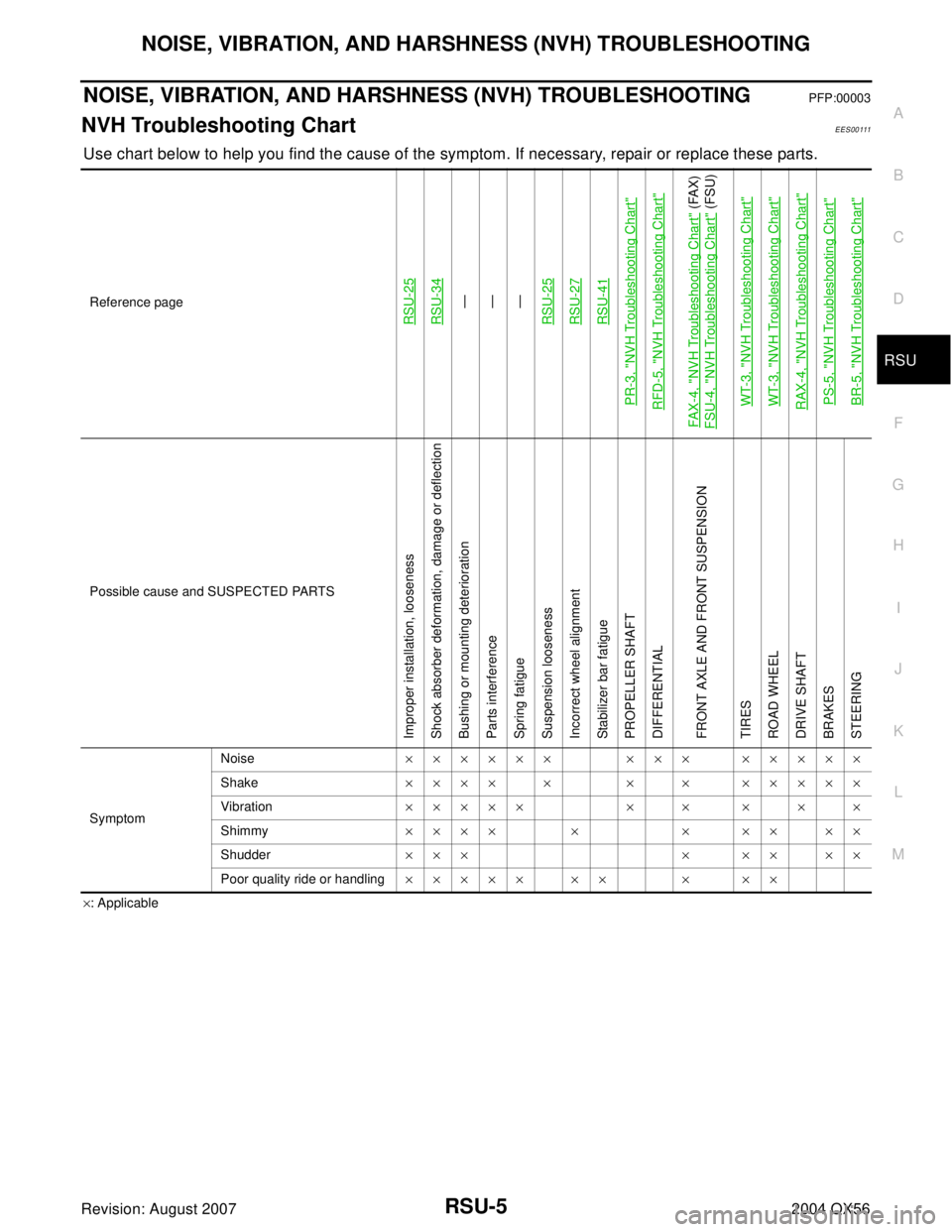
NOISE, VIBRATION, AND HARSHNESS (NVH) TROUBLESHOOTING
RSU-5
C
D
F
G
H
I
J
K
L
MA
B
RSU
Revision: August 20072004 QX56
NOISE, VIBRATION, AND HARSHNESS (NVH) TROUBLESHOOTINGPFP:00003
NVH Troubleshooting ChartEES00111
Use chart below to help you find the cause of the symptom. If necessary, repair or replace these parts.
×: Applicable Reference page
RSU-25RSU-34
—
—
—
RSU-25
RSU-27RSU-41
PR-3, "
NVH Troubleshooting Chart
"
RFD-5, "
NVH Troubleshooting Chart
"
FAX -4, "
NVH Troubleshooting Chart
" (FAX)
FSU-4, "
NVH Troubleshooting Chart
" (FSU)
WT-3, "
NVH Troubleshooting Chart
"
WT-3, "
NVH Troubleshooting Chart
"
RAX-4, "
NVH Troubleshooting Chart
"
PS-5, "
NVH Troubleshooting Chart
"
BR-5, "
NVH Troubleshooting Chart
"
Possible cause and SUSPECTED PARTS
Improper installation, looseness
Shock absorber deformation, damage or deflection
Bushing or mounting deterioration
Parts interference
Spring fatigue
Suspension looseness
Incorrect wheel alignment
Stabilizer bar fatigue
PROPELLER SHAFT
DIFFERENTIAL
FRONT AXLE AND FRONT SUSPENSION
TIRES
ROAD WHEEL
DRIVE SHAFT
BRAKES
STEERING
SymptomNoise×××××× ××× ×××××
Shake×××× × × × ×××××
Vibration××××× × × × × ×
Shimmy×××× × × ×× ××
Shudder ××× × ×× ××
Poor quality ride or handling××××× ×× × ××
Page 2866 of 3371
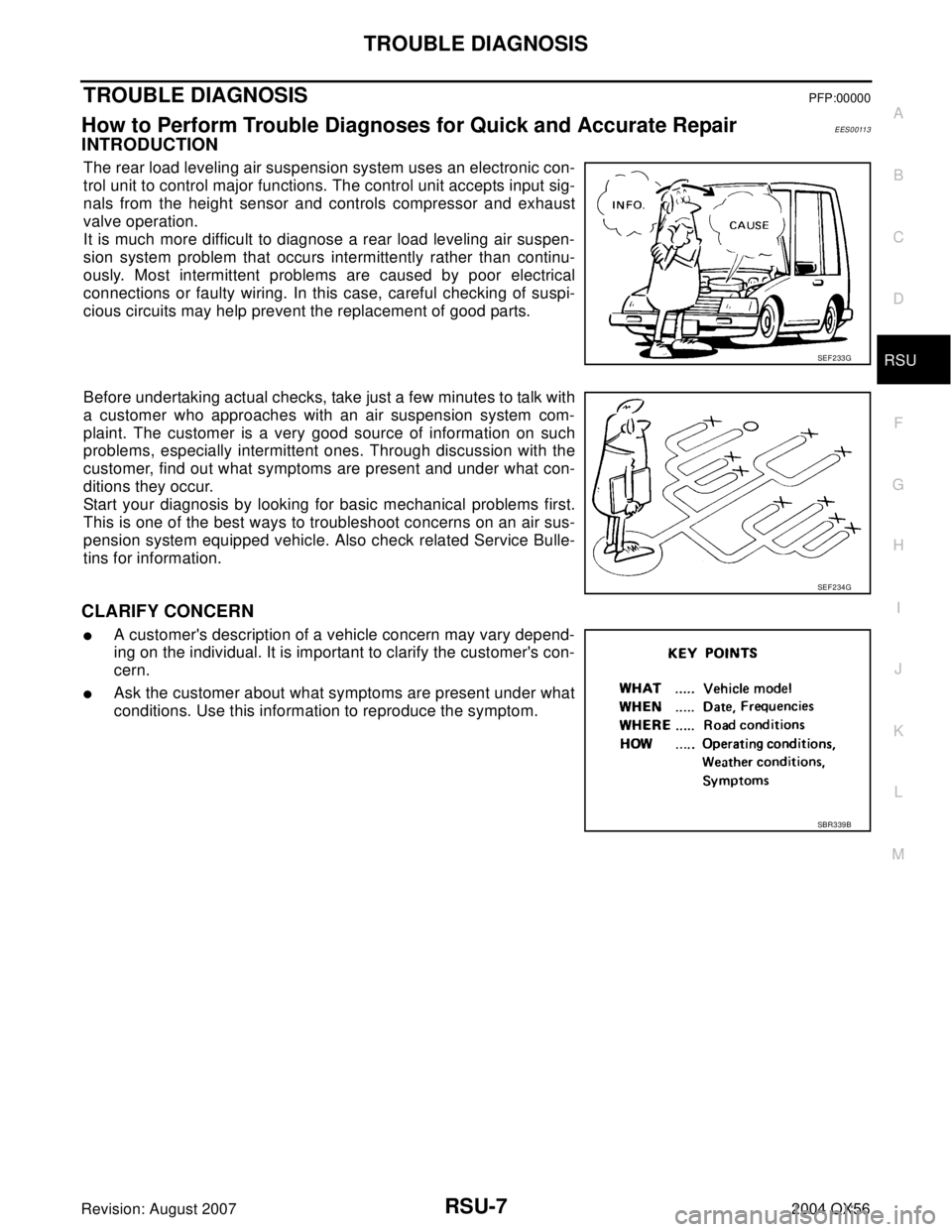
TROUBLE DIAGNOSIS
RSU-7
C
D
F
G
H
I
J
K
L
MA
B
RSU
Revision: August 20072004 QX56
TROUBLE DIAGNOSISPFP:00000
How to Perform Trouble Diagnoses for Quick and Accurate RepairEES00113
INTRODUCTION
The rear load leveling air suspension system uses an electronic con-
trol unit to control major functions. The control unit accepts input sig-
nals from the height sensor and controls compressor and exhaust
valve operation.
It is much more difficult to diagnose a rear load leveling air suspen-
sion system problem that occurs intermittently rather than continu-
ously. Most intermittent problems are caused by poor electrical
connections or faulty wiring. In this case, careful checking of suspi-
cious circuits may help prevent the replacement of good parts.
Before undertaking actual checks, take just a few minutes to talk with
a customer who approaches with an air suspension system com-
plaint. The customer is a very good source of information on such
problems, especially intermittent ones. Through discussion with the
customer, find out what symptoms are present and under what con-
ditions they occur.
Start your diagnosis by looking for basic mechanical problems first.
This is one of the best ways to troubleshoot concerns on an air sus-
pension system equipped vehicle. Also check related Service Bulle-
tins for information.
CLARIFY CONCERN
�A customer's description of a vehicle concern may vary depend-
ing on the individual. It is important to clarify the customer's con-
cern.
�Ask the customer about what symptoms are present under what
conditions. Use this information to reproduce the symptom.
SEF 2 33 G
SEF 2 34 G
SBR3 39 B
Page 2871 of 3371
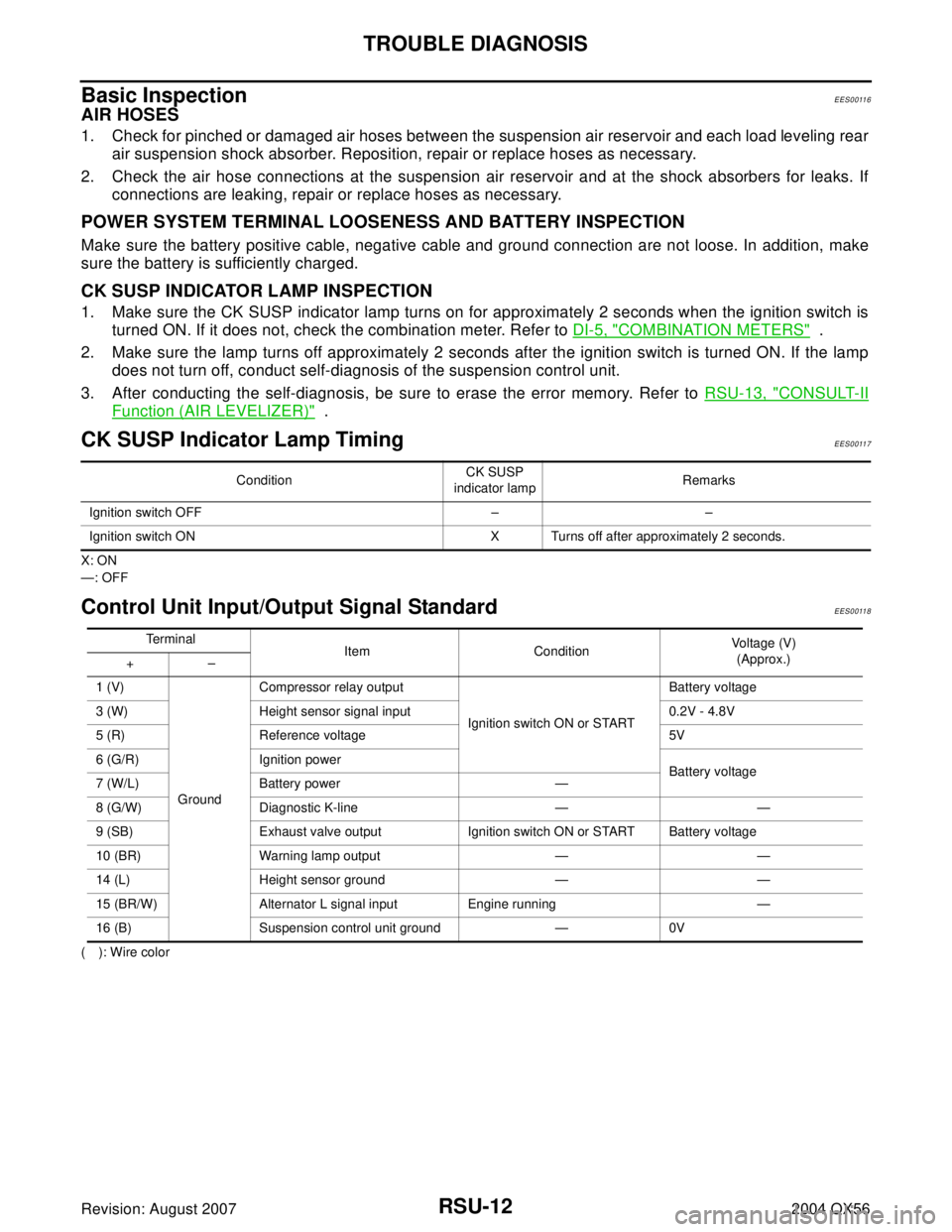
RSU-12
TROUBLE DIAGNOSIS
Revision: August 20072004 QX56
Basic InspectionEES00116
AIR HOSES
1. Check for pinched or damaged air hoses between the suspension air reservoir and each load leveling rear
air suspension shock absorber. Reposition, repair or replace hoses as necessary.
2. Check the air hose connections at the suspension air reservoir and at the shock absorbers for leaks. If
connections are leaking, repair or replace hoses as necessary.
POWER SYSTEM TERMINAL LOOSENESS AND BATTERY INSPECTION
Make sure the battery positive cable, negative cable and ground connection are not loose. In addition, make
sure the battery is sufficiently charged.
CK SUSP INDICATOR LAMP INSPECTION
1. Make sure the CK SUSP indicator lamp turns on for approximately 2 seconds when the ignition switch is
turned ON. If it does not, check the combination meter. Refer to DI-5, "
COMBINATION METERS" .
2. Make sure the lamp turns off approximately 2 seconds after the ignition switch is turned ON. If the lamp
does not turn off, conduct self-diagnosis of the suspension control unit.
3. After conducting the self-diagnosis, be sure to erase the error memory. Refer to RSU-13, "
CONSULT-II
Function (AIR LEVELIZER)" .
CK SUSP Indicator Lamp TimingEES00117
X: ON
—: OFF
Control Unit Input/Output Signal StandardEES00118
( ): Wire colorConditionCK SUSP
indicator lampRemarks
Ignition switch OFF – –
Ignition switch ON X Turns off after approximately 2 seconds.
Te r m i n a l
Item ConditionVoltage (V)
(Approx.)
+–
1 (V)
GroundCompressor relay output
Ignition switch ON or STARTBattery voltage
3 (W) Height sensor signal input 0.2V - 4.8V
5 (R) Reference voltage 5V
6 (G/R) Ignition power
Battery voltage
7 (W/L) Battery power —
8 (G/W) Diagnostic K-line — —
9 (SB) Exhaust valve output Ignition switch ON or START Battery voltage
10 (BR) Warning lamp output — —
14 (L) Height sensor ground — —
15 (BR/W) Alternator L signal input Engine running —
16 (B) Suspension control unit ground — 0V
Page 2872 of 3371
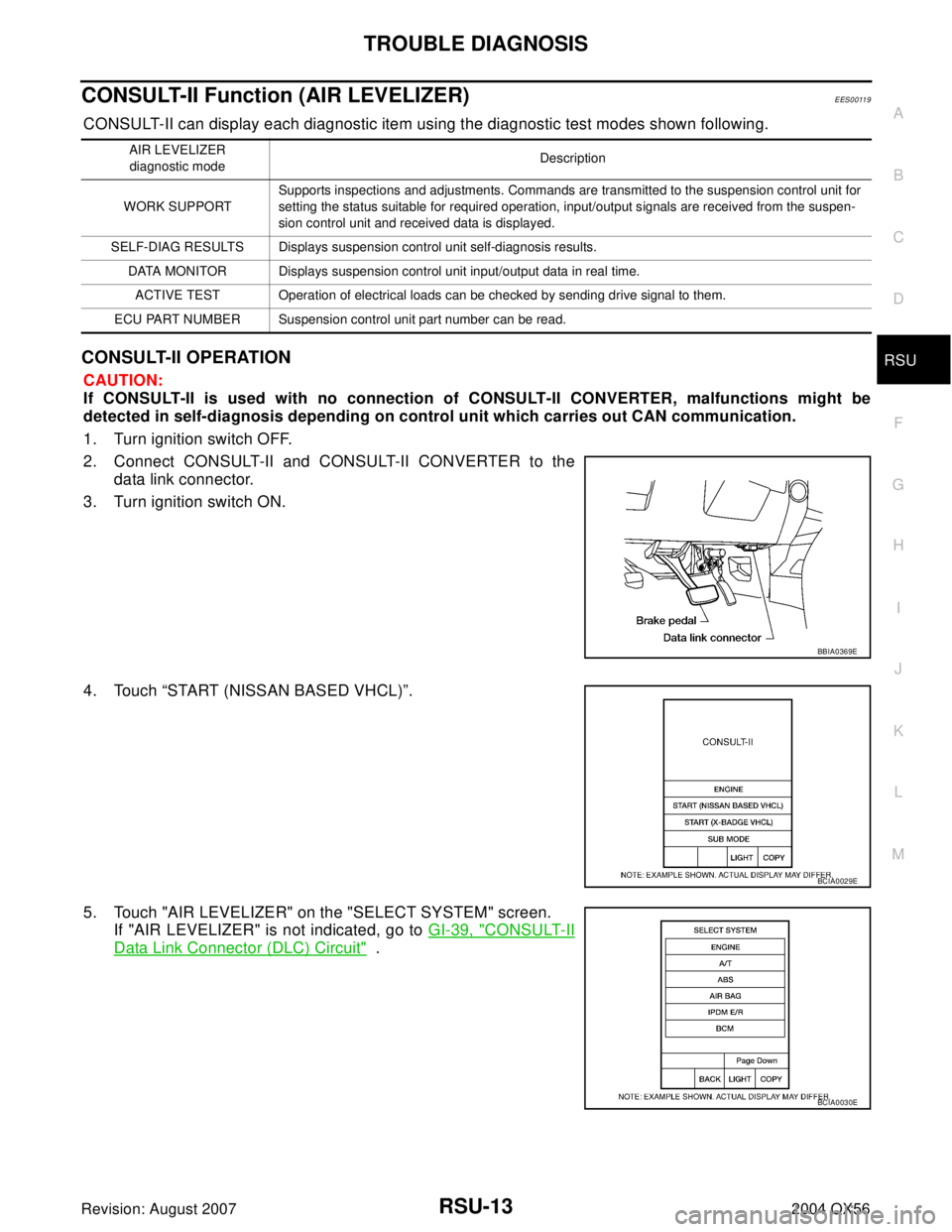
TROUBLE DIAGNOSIS
RSU-13
C
D
F
G
H
I
J
K
L
MA
B
RSU
Revision: August 20072004 QX56
CONSULT-II Function (AIR LEVELIZER)EES00119
CONSULT-II can display each diagnostic item using the diagnostic test modes shown following.
CONSULT-II OPERATION
CAUTION:
If CONSULT-II is used with no connection of CONSULT-II CONVERTER, malfunctions might be
detected in self-diagnosis depending on control unit which carries out CAN communication.
1. Turn ignition switch OFF.
2. Connect CONSULT-II and CONSULT-II CONVERTER to the
data link connector.
3. Turn ignition switch ON.
4. Touch “START (NISSAN BASED VHCL)”.
5. Touch "AIR LEVELIZER" on the "SELECT SYSTEM" screen.
If "AIR LEVELIZER" is not indicated, go to GI-39, "
CONSULT-II
Data Link Connector (DLC) Circuit" .
AIR LEVELIZER
diagnostic modeDescription
WORK SUPPORTSupports inspections and adjustments. Commands are transmitted to the suspension control unit for
setting the status suitable for required operation, input/output signals are received from the suspen-
sion control unit and received data is displayed.
SELF-DIAG RESULTS Displays suspension control unit self-diagnosis results.
DATA MONITOR Displays suspension control unit input/output data in real time.
ACTIVE TEST Operation of electrical loads can be checked by sending drive signal to them.
ECU PART NUMBER Suspension control unit part number can be read.
BBIA0369E
BCIA0029E
BCIA0030E
Page 2873 of 3371
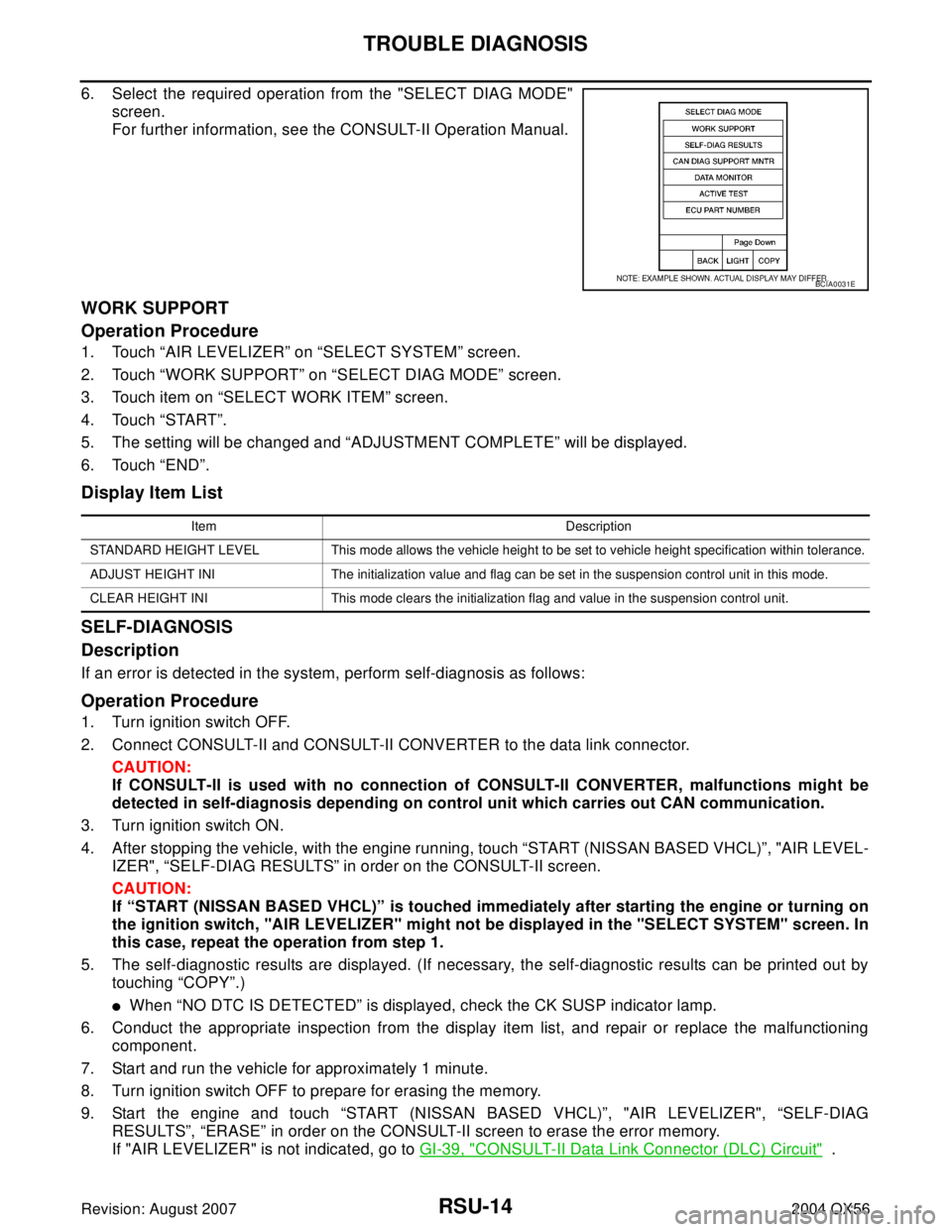
RSU-14
TROUBLE DIAGNOSIS
Revision: August 20072004 QX56
6. Select the required operation from the "SELECT DIAG MODE"
screen.
For further information, see the CONSULT-II Operation Manual.
WORK SUPPORT
Operation Procedure
1. Touch “AIR LEVELIZER” on “SELECT SYSTEM” screen.
2. Touch “WORK SUPPORT” on “SELECT DIAG MODE” screen.
3. Touch item on “SELECT WORK ITEM” screen.
4. Touch “START”.
5. The setting will be changed and “ADJUSTMENT COMPLETE” will be displayed.
6. Touch “END”.
Display Item List
SELF-DIAGNOSIS
Description
If an error is detected in the system, perform self-diagnosis as follows:
Operation Procedure
1. Turn ignition switch OFF.
2. Connect CONSULT-II and CONSULT-II CONVERTER to the data link connector.
CAUTION:
If CONSULT-II is used with no connection of CONSULT-II CONVERTER, malfunctions might be
detected in self-diagnosis depending on control unit which carries out CAN communication.
3. Turn ignition switch ON.
4. After stopping the vehicle, with the engine running, touch “START (NISSAN BASED VHCL)”, "AIR LEVEL-
IZER", “SELF-DIAG RESULTS” in order on the CONSULT-II screen.
CAUTION:
If “START (NISSAN BASED VHCL)” is touched immediately after starting the engine or turning on
the ignition switch, "AIR LEVELIZER" might not be displayed in the "SELECT SYSTEM" screen. In
this case, repeat the operation from step 1.
5. The self-diagnostic results are displayed. (If necessary, the self-diagnostic results can be printed out by
touching “COPY”.)
�When “NO DTC IS DETECTED” is displayed, check the CK SUSP indicator lamp.
6. Conduct the appropriate inspection from the display item list, and repair or replace the malfunctioning
component.
7. Start and run the vehicle for approximately 1 minute.
8. Turn ignition switch OFF to prepare for erasing the memory.
9. Start the engine and touch “START (NISSAN BASED VHCL)”, "AIR LEVELIZER", “SELF-DIAG
RESULTS”, “ERASE” in order on the CONSULT-II screen to erase the error memory.
If "AIR LEVELIZER" is not indicated, go to GI-39, "
CONSULT-II Data Link Connector (DLC) Circuit" .
BCIA0031E
Item Description
STANDARD HEIGHT LEVEL This mode allows the vehicle height to be set to vehicle height specification within tolerance.
ADJUST HEIGHT INI The initialization value and flag can be set in the suspension control unit in this mode.
CLEAR HEIGHT INI This mode clears the initialization flag and value in the suspension control unit.
Page 2875 of 3371
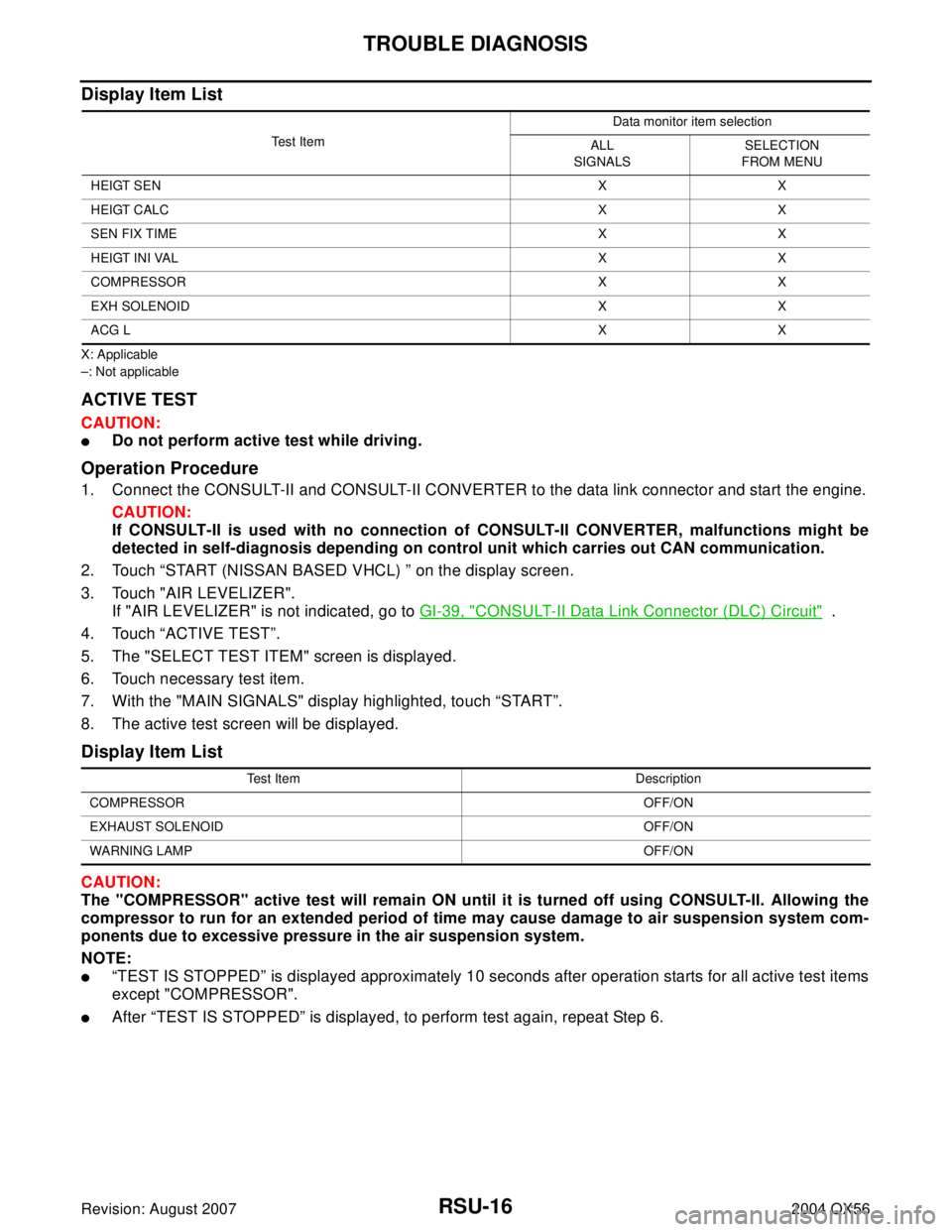
RSU-16
TROUBLE DIAGNOSIS
Revision: August 20072004 QX56
Display Item List
X: Applicable
–: Not applicable
ACTIVE TEST
CAUTION:
�Do not perform active test while driving.
Operation Procedure
1. Connect the CONSULT-II and CONSULT-II CONVERTER to the data link connector and start the engine.
CAUTION:
If CONSULT-II is used with no connection of CONSULT-II CONVERTER, malfunctions might be
detected in self-diagnosis depending on control unit which carries out CAN communication.
2. Touch “START (NISSAN BASED VHCL) ” on the display screen.
3. Touch "AIR LEVELIZER".
If "AIR LEVELIZER" is not indicated, go to GI-39, "
CONSULT-II Data Link Connector (DLC) Circuit" .
4. Touch “ACTIVE TEST”.
5. The "SELECT TEST ITEM" screen is displayed.
6. Touch necessary test item.
7. With the "MAIN SIGNALS" display highlighted, touch “START”.
8. The active test screen will be displayed.
Display Item List
CAUTION:
The "COMPRESSOR" active test will remain ON until it is turned off using CONSULT-II. Allowing the
compressor to run for an extended period of time may cause damage to air suspension system com-
ponents due to excessive pressure in the air suspension system.
NOTE:
�“TEST IS STOPPED” is displayed approximately 10 seconds after operation starts for all active test items
except "COMPRESSOR".
�After “TEST IS STOPPED” is displayed, to perform test again, repeat Step 6.
Te s t I t e mData monitor item selection
ALL
SIGNALSSELECTION
FROM MENU
HEIGT SENXX
HEIGT CALCXX
SEN FIX TIMEXX
HEIGT INI VALXX
COMPRESSOR X X
EXH SOLENOID X X
ACG LXX
Test Item Description
COMPRESSOROFF/ON
EXHAUST SOLENOIDOFF/ON
WARNING LAMPOFF/ON
Page 2876 of 3371
TROUBLE DIAGNOSIS FOR SELF-DIAGNOSTIC ITEMS
RSU-17
C
D
F
G
H
I
J
K
L
MA
B
RSU
Revision: August 20072004 QX56
TROUBLE DIAGNOSIS FOR SELF-DIAGNOSTIC ITEMSPFP:00000
Height Sensor System InspectionEES0011A
INSPECTION PROCEDURE
1. SELF-DIAGNOSIS RESULT CHECK
Check self-diagnosis results.
Is the above displayed in the self-diagnosis display items?
YES >> GO TO 3.
NO >> GO TO 2.
2. DATA MONITOR CHECK
Conduct data monitor of "HEIGT SEN" to check if the status is normal.
OK or NG
OK >> Inspection End.
NG >> GO TO 3.
3. CONNECTOR INSPECTION
1. Turn ignition switch OFF.
2. Disconnect suspension control unit connector B3 and height sensor C8.
3. Check the terminals for deformation, disconnection, looseness or damage.
OK or NG
OK >> GO TO 4.
NG >> Repair or replace as necessary.
Self-diagnosis results
C1801
C1806
C1807
HEIGT SEN 0.2V - 4.8V